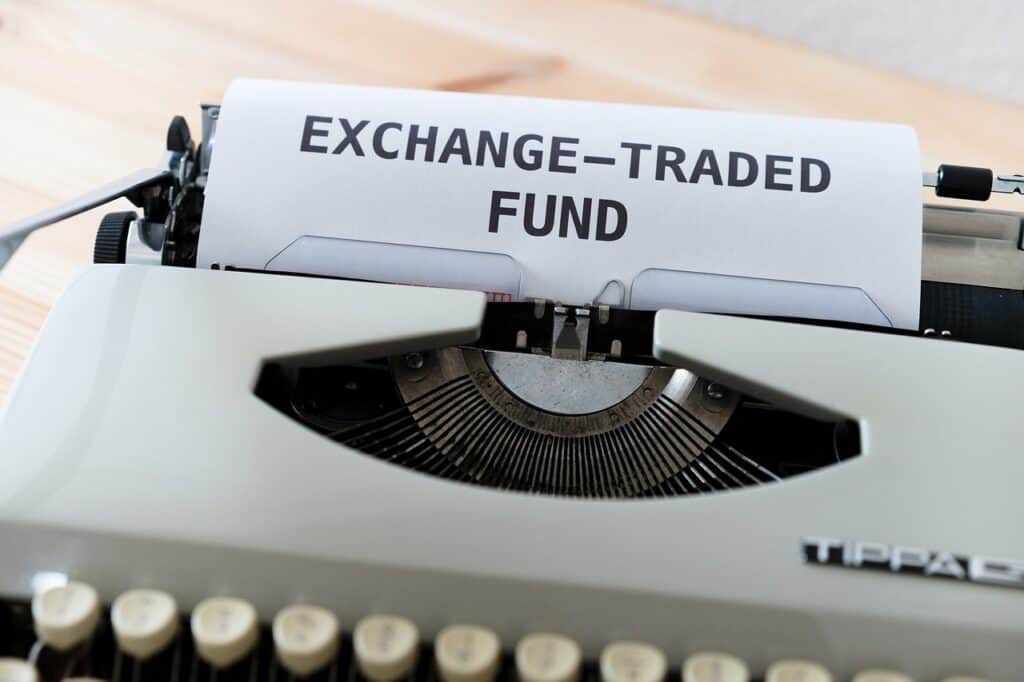Investing in ETFs can be a great method for Canadians to grow their wealth.
Building a great investment portfolio can go a long way to helping Canadians achieve a state of financial wellness.
But for some, it’s easier said than done
Understanding the Canadian investing landscape can be challenging, and it may feel like a full-time job just to stay on top of the financial trends. Investment vehicles like stocks, bonds, ETF’s, Mutual Funds, REIT’s, and Cryptocurrencies can sometimes overcomplicate what is a very simple process.
If you want to be a day trader, you’ll need an in-depth knowledge of these terms, but for those who are looking to steadily build wealth, and live a rich life, you only need to know where the building blocks need to go, not how the building is made.
In this post, we’ll talk about one of the trendiest investment options for Canadians……ETFs.
Googling “What is an ETF?” will lead you down a personal finance rabbit hole that can be frustrating, and may result in you ditching the entire learning experience altogether. I’ve pulled a few highlights from what I consider to be great source material to help provide the benefits and the drawbacks of bonds
Terms You Need to Know
Bull Market: A bull market is the condition of a financial market in which prices are rising or are expected to rise. The term “bull market” is most often used to refer to the stock market but can be applied to anything that is traded, such as bonds, real estate, currencies and commodities (Investopedia)
Bear Market: A bear market is when a market experiences prolonged price declines. It typically describes a condition in which securities prices fall 20% or more from recent highs amid widespread pessimism and negative investor sentiment (Investopedia.com).
Index: An index is a method to track the performance of a group of assets in a standardized way. Indexes typically measure the performance of a basket of securities intended to replicate a certain area of the market. These could be a broad-based index that captures the entire market, such as the Standard & Poor’s 500 Index or Dow Jones Industrial Average (DJIA), or more specialized such as indexes that track a particular industry or segment. (Investopedia)
Fixed Income: Fixed income is a class of assets and securities that pay out a set level of cash flows to investors, typically in the form of fixed interest or dividends (Investopedia.com).
Read: Complete Guide to TFSA’s
Read: Complete Guide to RRSP’s & Your Complete Guide to RESP’s
- Here are 8 things Canadians Need to Know About Investing in ETFs
- 1. Investing in ETFs – What is an ETF?
- 2. ETFs are Passively Managed
- 3. What Is the Difference Between Active and passive Investing?
- 4. ETFs Have Fees
- 5. Positives of Buying ETFs
- 6. Negatives of ETFs
- 7. Investing in ETFs – Who Should Buy ETFs?
- 8. Investing in ETFs – Where Do I Buy ETFs?
- Conclusion
- Investing in ETFs – FAQ
- 4 Tips to Help You on Your Financial Wellness Journey

Stay up to Date on the Latest Travel Deals
Here are 8 things Canadians Need to Know About Investing in ETFs
1. Investing in ETFs – What is an ETF?
You’ve probably heard a lot about ETFs
Exchange traded funds are a type of security that tracks an index, sector, or other asset but can be purchased and sold on stock exchanges like regular stocks.
ETFs come in many different structures to reflect the various types of strategies they follow such as investing only in certain commodities while others invest across multiple markets at once.
A well-known example of an ETF is the SPDR S&P 500 ETF (SPY), which tracks the S&P 500 Index.
ETFs can also track certain industries as well. For example, there is Cryptocurrency ETFS & an ETF comprised of Cannabis stocks.

Most people use the terms ETF and Index Fund interchangeably, and I wouldn’t get too hung up on the difference between the two.
ETFs are trending up in terms of popularity amongst investors, and it’s not hard to see why. You’ve probably heard that a diverse investing portfolio is a good idea. ETFs take that theory and put it into reality.
If you buy an ETF, you are buying a pre-packaged bundle of stocks.
ETFs are seen as an alternative to investing in individual stocks. Hypothetically, If you have $1,000 to invest, you can go out and buy one stock, or you can buy one ETF, which will consist of a bundle of stocks and/or bonds.

As more and more investors are leveraging easy-to-use technology platforms for investing purposes (more of a “let the experts do it” approach), ETFs are allowing Canadians to build diverse portfolios without having to make investing a full-time job.
2. ETFs are Passively Managed
Rather than being managed by a traditional fund manager, ETFs are typically managed by computer algorithms that track certain aspects of the market as a whole (examples could be the Canadian Bond Market or the S&P 500).
ETFs also tend to be passively managed, which means that your investments are trying to track the market rather than beating the market. If the S&P 500 goes up 5% over the year, the ETF tracking this index will also go up 5%.
There are ETFs out there that attempt to beat the market (actively managed), however, these are less prevalent than the passively managed ETFs.
As a result, ETFs are great investments for Canadians who aren’t looking to strike it big by choosing individual stocks but are satisfied with having their investments increase & decrease alongside the market as a whole.
Considering most Canadians don’t have the time to be glued to Bloomberg radio, ETFs are growing in popularity at a rapid rate.
3. What Is the Difference Between Active and passive Investing?
As mentioned above, ETFs are passively managed, as opposed to actively managed. These are two very different investment strategies.
Before determining if you should go the ETF route, you first need to decide if you want to take an active or a passive approach to investing.
Active Investing involves a human manager buying and selling stocks through mutual funds. The goal of active investing is to simply beat the market.
Passive investing on the other hand involves investing in an index or ETFs and is typically run by computer algorithms. The goal of passive investing is to have your money grow at the rate of the market.
| Active Investing Beliefs | Passive Investing Beliefs |
| Humans can outsmart algorithms, and by actively picking the appropriate stocks you can beat market returns | Machine algorithm will keep you at the market level. If the market goes up 5%, your investments will go up 5% |
| Diversification isn’t as important, as I can pick stocks that can beat the market | My profile will be heavily diversified |
| I want to have a high level of control over my investments | I don’t need a lot of control, as my investments will be tracking the performance of the market as a whole |
Whether you’d like to be an active or a passive investor is all dependent on the individual. Many Canadians have components of both within their investments.
For example, you can passively invest your RRSP and TFSA with a Robo-Advisor, while actively investing in the cryptocurrency market on the side.
4. ETFs Have Fees
Investing in ETFs comes with a cost.
As we’ve touched on, one of the benefits of buying ETFs is that the stocks/bonds have been pre-selected. You’re buying the entire basket of funds. Since there is some work being done behind the scenes, there is a fee associated with ETFs
The cost of this service is called the Management Expense Ratio (MER).
On average, your ETF fees will range somewhere from 0.05% to 0.25%. While this certainly isn’t free (like going out and picking everything individually would be), this is much cheaper than investing in Mutual Funds, which can charge fees upwards of 2% – 2.5%.
As a result, ETFs are seen as a very cheap way to invest in a wide variety of stocks.

5. Positives of Buying ETFs
Lower Fees
We mentioned earlier that ETFs are typically not managed by humans, but rather by algorithms. One of the positives about an algorithm being in charge is that the fees are drastically lower than some investing options (Mutual Funds for example).
This is great for new investors because the barrier to entry is lower from a cost perspective, but also great for Canadians who don’t want to reduce their earnings by paying hefty management fees (Canada as a country has extremely high management fees compared to other countries).
Diversification
If you have 25% of your investments in Tesla, and the Tesla stock tanks, you will be in a world of financial hurt (remember Enron & Lehman Brothers).
Investing in ETFs allows you to invest in several stocks, diversifying your portfolio, and ultimately reducing your risk.
You Don’t Have to Get Your Hands Dirty
30-40 years ago it would be a full-time job trying to pick the right stocks, diversify your portfolio appropriately, and actively manage the ups and downs of the market.
People just don’t have time to do that in 2022.
Since the stocks & bonds available in an ETF are preselected, you don’t have to go through the headache of picking individual stocks. This is great for Canadians who don’t want to get their hands dirty with the stock market daily. You can select the ETF that’s right for you, and go back to living your life.
Predictability
ETFs provide a fairly predictable stream of income. If you have ETFs in the stock market, your ETF will rise and fall predictably with the stock market. The same can be said if you have an ETF comprised of bonds.
Individual stocks can rise and fall daily, but the bundled product will move as one with the market. You won’t get the extreme volatility commonly associated with the stock market.

Dividends
Some ETFs pay dividends, which allow you to earn passive income over time. The dividend payout is sometimes communicated by the investment advisor.
6. Negatives of ETFs
Little to No Chance of Beating the Market
While steadily increasing your wealth makes sense for a lot of people, some Canadians would prefer to take a riskier approach with their investments.
We all want to be the person to pick the next big stock and ride those earnings to financial glory.
Investing in ETFs is not conducive to that approach. ETFs are a long-term strategy, where your money increases steadily year over year.
If you want to gamble a bit more, you’re going to have to go in a different direction.
No Flexibility
You don’t control the stocks and bonds available in an ETF. If you invest in an ETF, you will have to be comfortable with the fact that you can’t pick and choose which stocks within the ETF you want. It comes as a package, for better or worse.
7. Investing in ETFs – Who Should Buy ETFs?
Beginners to the Stock Market
Let’s be honest, investing in the stock market can feel overwhelming if you’re a beginner. The thought of going out and buying individual stocks, and mixing those stocks with the right bonds can flat-out deter people from dipping their toe in the investment pool.
This is why ETFs are fantastic. They’re an alternative to picking stocks and bonds individually
The particular ETF you choose to invest in has already gone out and chosen the right asset mix.
It’s the difference between buying a pre-made meal and making everything from scratch. One option is far easier than the other.
8. Investing in ETFs – Where Do I Buy ETFs?
Understanding ETFs can be difficult, but buying ETFs is easy.
Any trading platform can offer ETFs. If you’re currently doing traditional investments, the platform you’re using can accommodate ETF trading.
If you currently do not have any personal investments of any kind, there are several trading platforms in the market that are easy to use.
Here are 5 of the top trading platforms in the market according to stockbrokers.com
| Online Broker | Best For | Commission | Overall Rating |
|---|---|---|---|
| Questrade | Best Overall | $.01 per share | 4.5 Stars |
| Qtrade Investor | Best for Research | $8.75 | 4.5 Stars |
| Interactive Brokers | Best for Professionals | $.005 per share | 4 Stars |
| TD Direct Investing | Diverse Trading Tools | $9.99 | 4 Stars |
| CIBC Investor’s Edge | Transparent Fees | $6.95 | 4 Stars |
Investing in ETFs only requires 2 steps:
- Open a brokerage account (see above)
- Buy the ETFs
The ETFs will take it from there.
In Canada, one of the more popular trends is to open up an RRSP with a “robo-advisor”
Traditional vs Robo-Advisors
If you’ve concluded that ETFs have a place in your investment portfolio, that’s great! The next decision in this process is to determine which financial institution you’d like to place your money with.
In Canada, this decision usually comes down to two choices: a traditional financial institution, or a robo-advisor.
In Canada, one of the more popular trends is to open up an RRSP with a “robo-advisor”
What is a Robo-Advisor?
A robo-advisor is a service that uses computer algorithms to build and manage your investment portfolio. You set the parameters, such as time horizon and how much risk you’ll accept from them; then let these models do all of the hard work for you.
Robo-advisors are a great low-cost alternative to traditional investment management services.
Robo-advisors can automate investing strategies that optimize the ideal asset class weights in a portfolio for a given risk preference. Some traditional advisors are now offering robo-advisors-as-a-service as part of the portfolio construction and investment monitoring side of a more holistic financial planning practice
Robo-advisor is best for the following individuals:
- Those who are technologically savvy
- Those looking to save on investment fees
- Entry level investors
- Those who use a traditional financial advisor, but do not engage with them regularly
Robo-Advisor vs Traditional Financial Advisors
| Benefits of Financial Advisors | Benefits of Robo-Advisors |
| The human element means you can call someone in case you have a question. The importance of technology is somewhat lessened. | The fees are much lower than traditional advisors, and the ease of opening a portfolio cannot be stressed enough. |
| Financial advisors tend to offer a portfolio based on face to face meetings rather than an online questionnaire | The consumer-facing platforms are much easier to use compared to their traditional counterparts. |
| Most financial advisors can answer questions about topics that go beyond investment & retirement portfolios (life insurance, annuities, etc) | The consumer facing platforms are much easier to use compared to their traditional counterparts. |
Robo-Advisor Options in Canada
If you have questions about robo-advisors, or if you feel you may benefit by switching to a technology-based solution, I strongly encourage you to check out Wealthsimple.
It won’t take much research to conclude that Wealthsimple is Canada’s top robo-advisor, and it’s a product I use. Wealthsimple it is a robo-advisor, but still provides clients with access to human advisors to answer their questions (a best-of-both-worlds situation). Wealthsimple offers an easy-to-use platform and does not require a minimum investment to get started.
Here is a detailed review of the user experience by Canadian Youtuber Brandon Beavis
Bottom line…….check out Wealthsimple. You can sign up through this link below
Conclusion
Investing in ETFs won’t lead to maximum returns, but investing isn’t about chasing maximum returns all day every day. You want to have a long-term approach, and part of that is being able to withstand the ebbs and flows in the market.
The diversification offered by ETFs reduces your overall risk and will allow you to steadily increase your wealth.
Investing in ETFs – FAQ
Why are ETFs Share Prices Different?
When investing in ETFs you may notice that certain ETFs cost more per share than others, even though they’re tracking the same index.
It’s important to understand that these price differences DON’T MATTER. Some investment advisors chop up their shares more than others.
Assuming the fund lineup is the same, 2 $20 shares of one advisor ETF is equal to 1 $40 share of another
What Percent of My Investment Portfolio Should be ETFs?
This is why I love Robo-Advisors like Wealthsimple. They will automate your investments based on your risk profile. If you have a lower risk tolerance, they will skew your investments more towards bonds.
It’s an extremely easy way to ensure your investment strategy is appropriate, while also saving on fees. Robo-Advisors can also adjust the percentage of your portfolio invested in bonds over time.
If you’d prefer more of an active approach to investing, you can have as many ETFs in your profile as you’d like. It’s a good idea to ensure you have an appropriate mix of stocks and bonds within your fund lineup. As long as you are properly invested in the market, it should be considered a win.
What are the Different Types of ETFs?
There are different types of ETFs in the market including:
- Bond ETFs – which may include government or corporate bonds
- Industry ETFs – which track a particular industry (healthcare for example)
- Currency ETFs – which invest in different international currencies
What are the top Canadian ETFs?
This list provided by Wealthsimple can help guide you on your ETF buying journey.
4 Tips to Help You on Your Financial Wellness Journey
- Determine the investment vehicle that’s right for you (TFSA, RRSP, RESP).
- Use the tax-advantaged accounts offered by the Canadian government to help reduce your taxation.
- Conclude whether or not you should be investing in a traditional or a robo-advisor.
- If you prefer a passive approach toward investments, ensure that ETFs are a part of your investment portfolio. Investing in ETFs improves the overall diversity of your portfolio
Canadian Investment Series
Read >>> Investing in ETFs
Read >>> Investing in Stocks
Disclaimer: this post may contain affiliate links, meaning we get a small commission if you make a purchase through our links, at no cost to you. For more information, please visit our disclaimer page
